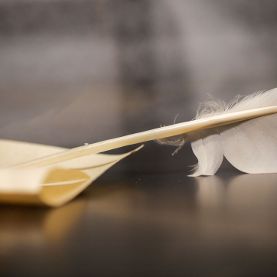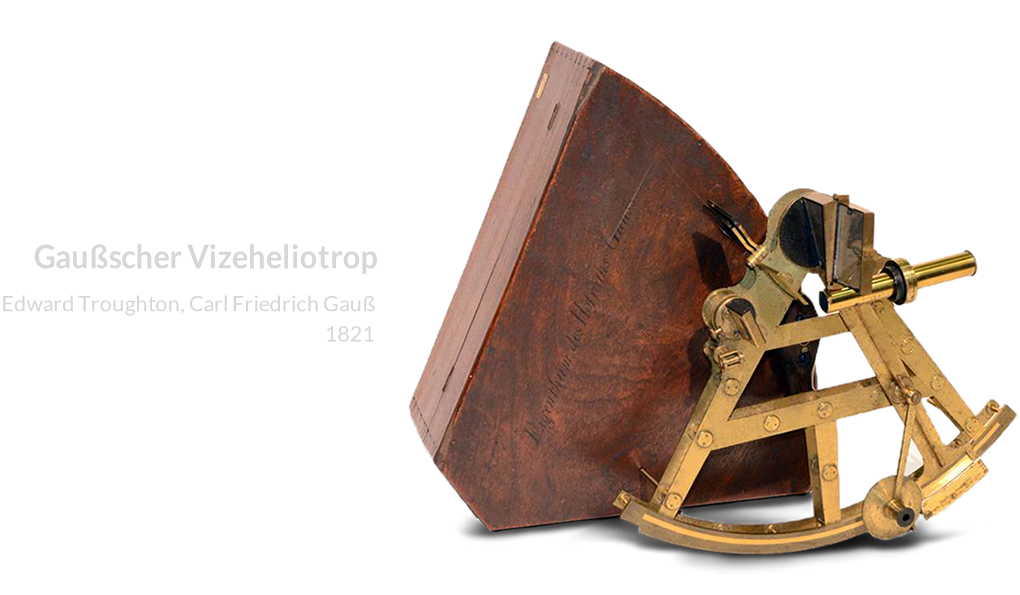Das Fach ist derzeit nicht bestückt.
Wir verweisen hier digital auf eine Auswahl von Handschriften und Urkunden aus der Sammlung. Klicken Sie auf die Bilder im Karussell des Fachs.
Wachsabguss des Königssiegels Friedrichs III.
Friedrich III. kam aus dem Haus der Habsburger und war ab 1440 König sowie ab 1452 bis zu seinem Tod im Jahr 1493 Kaiser. Das Siegel zeigt ihn noch als König, der unter einem Baldachin sitzt. Auf dem Kopf trägt er eine mit einem Kreuz geschmückte Krone, in der Rechten das Zepter, in seiner Linken den Reichsapfel. In die Thronstufe ist das Sekretsiegel eingedrückt, ein weiteres, kleineres Siegel. Es sind Schilder zu sehen, die u.a. den Reichsadler sowie das österreichische Wappen zeigen.
1443-1450
Wachsabguss des Siegels Kaiser Karls IV. (Rückseite)
Die Rückseite des Siegels Karls IV. zeigt die Stadt Rom, und zwar in Form eines Stadttores, das von zwei Türmen flankiert wird. Die Umschrift besagt: „Rom, Hauptstadt der Welt, lenkt die Zügel des runden Erdkreises“ (ROMA CAPVT MVNDI REGIT ORBIS FRENA ROTVNDI). Im Torbogen steht: „Goldenes Rom“ (AVREA ROMA). Die Stadt wird hier als ehrwürdiger Sitz der Weltherrschaft dargestellt, das Römische Reich dauert gewissermaßen immer noch an.
1356
Ältestes Siegel der Stadt Göttingen
Die Replik zeigt das älteste Siegel der Stadt Göttingen mit einer stilisierten Stadtbefestigung in Form von drei Türmen. Die seitlichen Türme sind zweigeschossig, haben vier Fenster und außerdem ein Kreuz auf der Spitze. Zu sehen ist außerdem der Löwe, der das Wappenbild der welfischen Herzöge ist. Hierdurch wird darauf hingewiesen, dass Göttingen zum welfischen Territorium gehörte. Die Umschrift lautet: „Siegel der Bürger in Göttingen“ (SIGILLVM BURGENSIVM IN GOTINGEN).
1278 / Reproduktion
Siegel Heinrich des Löwen
Heinrich der Löwe war sicherlich eines der bekanntesten Mitglieder des Geschlechts der Welfen. Er war Herzog von Sachsen (1142-1180) und von Bayern (1156-1180). Ab 1176 verschlechtere sich sein Verhältnis zu Kaiser Friedrich I. Barbarossa, schließlich begab er sich nach England ins Exil. Nachdem man ihm seine beiden Herzogtümer aberkannt hatte, führte er dieses Siegel, das ihn immerhin noch „Herzog Heinrich“ nennt (SIGILLVM HENRICI DUCIS). Es handelt sich um das älteste Wappensiegel der Welfen.
1191 / Reproduktion
Wachsabguss des ältesten Siegels des Domkapitels Mainz
Dem Mainzer Domkapitel oblagen wichtige Aufgaben wie die Wahl des Erzbischofs oder die Besetzung von anderen Führungspositionen. Das Siegel zeigt den hl. Martin als Erzbischof und als Patron des Mainzer Domes (SCS MARTINVS SCE MAGUNTINE SEDIS PATRONUS). Zu sehen sind seine Kleidung einschließlich der Kasel, der Dalmatik, dem Pallium sowie eine mit Borten besetzte Mitra. In seiner Rechten hält er den Bischofsstab, in der Linken ein geöffnetes Buch, das den Kern der bischöflichen Predigt enthält.
13. Jahrhundert
Diplomatischer Apparat
Der Diplomatische Apparat (Apparatus diplomaticus) ist eine wissenschaftliche Einrichtung der Philosophischen Fakultät. Er umfasst eine beispiellose Sammlung von weit mehr als tausend Schriftzeugnissen aus Spätantike, Mittelalter und Früher Neuzeit, abgefasst in verschiedensten, insbesondere alten und außereuropäischen Sprachen (u.a. Latein, Mitteldeutsch, Altgriechisch, Hebräisch, Arabisch, Persisch, Türkisch, Tamilisch, Singhalesisch). Schon in der Gründerzeit der Universität, existierte ein didaktisch ausgerichtetes „Diplomatisches Cabinet“, das seit 1759 der Diplomatik, der Lehre zur Erschließung und Erforschung von Urkunden, diente, aber auch Handschriften, Siegel und Kupferstich-Reproduktionen barg. Noch im heutigen, 1802 angelegten Apparat bilden Papst-, Kaiser-, Königs- sowie geistliche, dynastische, städtische und bürgerliche Privaturkunden den Grundbestand.








